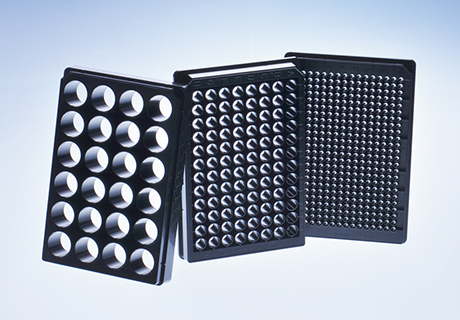CELLVIEW MICROPLATE, 96 WELL, CYCLOOLEFIN, F-BOTTOM (CHIMNEY WELL), GLASS BOTTOM, BLACK, TC, LID, STERILE, SINGLE PACKED
SENSOPLATE - GLASS-BOTTOM MICROPLATES
The research of biomolecular processes on the level of single molecules and in volume ranges equivalent to the size of a single bacterium is of immense importance, both in basic research and in industrial high-throughput screening.
The combination of modern confocal optics, new fluorescent dyes, sensitive photomultipliers and improved data processing has revolutionised the technique of fluorescence correlation spectroscopy (FCS). Over the past few years this has led to its widespread appli-cation, and alongside the technological advances in hardware development, Greiner Bio-One worked hand-in-hand with customers and instrument suppliers to develop the glass bottom microplates. These better satisfy the requirements of fluorescence correlation spectroscopy with regards to optical clarity and deformation when compared to standard polystyrene plates. In addition to fluorescence correlation spectroscopy, microscopic applications such as confocal microscopy are a potential field of application for glass-bottom microplates.
Sub Categories
Product Highlights
SENSOPLATE MICROPLATE, 96 WELL, PS, F-BOTTOM, GLASS BOTTOM, BLACK, LID, STERILE, SINGLE PACKED
MICROPLATTE, 1536 WELL, GLASS BOTTOM, F-BOTTOM, SENSOPLATE, LOBASE, LID, BLACK, STERILE,
Scientific Publications / PDF, 2 MB
Scientific Publications / PDF, 479 KB
Application Notes / PDF, 451 KB
Scientific Publications / PDF, 3 MB
Scientific Publications / PDF, 2 MB
Application Notes / PDF, 1 MB
Scientific Publications / PDF, 445 KB







